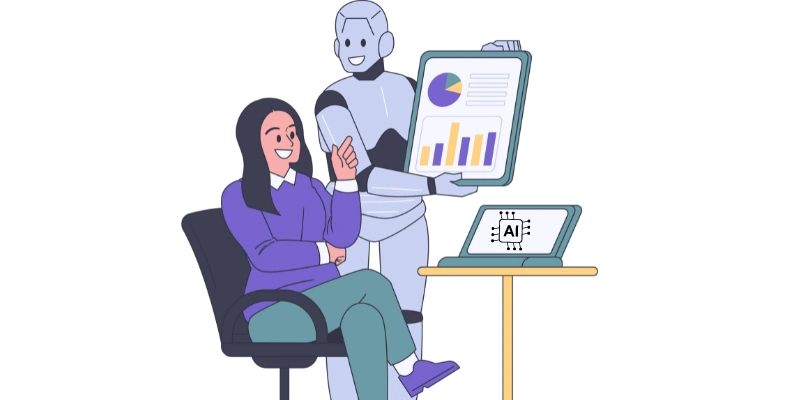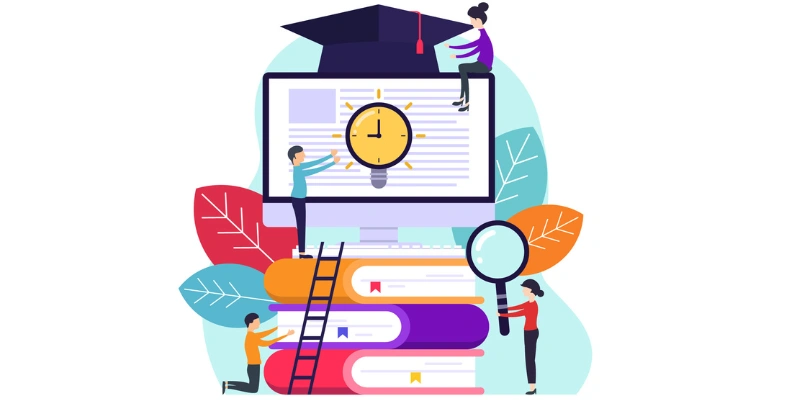
You may have noticed the increasing prevalence of Artificial Intelligence (AI) in various fields, including education. AI in education utilises intelligent algorithms and machine learning to enhance learning by making it more engaging, personalised, and efficient. Whether it is tailoring education to individual learning needs, alleviating teachers’ workloads, or preparing students for a technology-driven future, AI is revolutionising the learning process. Here we will explore A Beginners Guide to AI in Education some of the most impactful examples of AI in education and how they are reshaping classrooms today.
AI-Driven Personalised Learning

One of the best things about AI is how it can create personalised learning experiences for each student. Gone are the days of the “one-size-fits-all” approach. With AI, lessons can be tailored to fit how you learn best—whether you are breezing through math or stuck on a tricky concept.
How AI Adapts to Your Learning Style
So, how does AI pull this off? It tracks how you are doing with different subjects. For instance, if you are having a difficult time with geometry, AI can send extra resources your way—like practice problems or even a virtual tutor. But if you are crushing it in science, the system can ramp up the difficulty to keep you challenged. The idea is to give you the right kind of support at the perfect time, so you stay on track and understand what you are learning.
Examples of AI Tools That Make This Happen
- DreamBox Learning: If math is not your thing, DreamBox has you covered. It is an AI-powered platform that tweaks the lesson based on your progress in real time. Plus, it gives you hints and nudges in just the right direction.
- Smart Sparrow: This one lets teachers build lessons that adjust based on how students respond. It is like having a lesson that is designed just for you, adapting along the way.
- Knewton: Knewton uses AI to watch how you are doing and then suggests personalised content, so you are always learning at your own pace.
AI-Powered Virtual Assistants
Virtual assistants are quickly becoming a popular tool for both students and teachers. These AI-powered helpers can assist with a wide range of tasks, from answering simple questions to providing tailored study recommendations based on a student’s needs. The most important advantage is their 24/7 availability, meaning students no longer have to wait for the next class or office hours to get the help they need.
Why Virtual Assistants Rock in Education
Here are a few reasons why AI-powered assistants are making waves:
- Instant Help: Need an answer? Just ask. These assistants can give you info immediately, cutting down the time you would spend waiting around.
- Personalised Chats: They are not just spitting out facts—they can chat with you like a human, offering advice or even a little motivation when you require it.
- Helping Teachers Out: By managing some of the admin stuff (like scheduling or assignments), virtual assistants free up teachers to focus on teaching.
A Few Popular Virtual Assistants to Check Out
- Google Assistant for Education: From homework help to quick research, Google Assistant can do it all. It is like having a study buddy that knows pretty much everything.
- IBM Watson Tutor: Watson breaks things down step by step, especially for those tricky subjects. It is like having a tutor on standby.
- Microsoft Cortana: Cortana helps students stay organised, whether it is setting reminders or helping out with research, this is very handy for staying on top of things.
Beginners Guide to AI in Education – AI for Grading and Feedback
Let us face it, grading takes forever. However, AI can speed things up while still giving students mindful feedback. Whether it is automatically grading multiple-choice tests or giving you tips on your essay, AI is a huge help for teachers and students alike.
How AI Makes Grading Easier
AI tools can grade simple tests automatically, and when it comes to essays, they can point out things like grammar mistakes or even offer feedback on structure. This saves teachers a ton of time and keeps grading fair and consistent.
Examples of Tools That Make Grading a Breeze
- Grammarly: You have probably heard of this one. Grammarly’s AI helps polish your writing, catching grammar mistakes, awkward phrases, and more. It is like having an editor in your back pocket.
- Gradescope: This one is for the teachers. Gradescope uses AI to help them grade faster, from multiple-choice questions to even handwritten answers.
- Turnitin: Known for checking originality, Turnitin also gives feedback on writing quality, assisting students improve before turning in their work.
- Graidy.Tech: Graidy.Tech is another great AI-powered tool that simplifies grading. It automates a lot of the manual grading process, giving teachers more time to focus on teaching while still ensuring students get quality feedback.
AI-Powered Language Learning

Learning a new language can be challenging, but AI is making the process more engaging and enjoyable. Whether you’re working on pronunciation or expanding your vocabulary, AI-powered tools provide personalised feedback and targeted practice. This tailored approach helps you improve more efficiently and reach fluency faster than traditional methods.
How AI Helps You Master a New Language
AI tools in language learning use natural language processing (NLP)—basically, they understand what you are saying and can give you tips on how to improve. You can get instant feedback on pronunciation or even have a conversation simulation to practice your speaking skills.
Examples of Best AI-Language Learning Tools Out There
- Duolingo: A favorite for a reason, Duolingo uses AI to adjust lessons based on how well you are doing. Plus, the game-like approach keeps you coming back for more.
- Rosetta Stone: Using speech recognition tech, Rosetta Stone listens to your pronunciation and gives feedback in real time, making it great for boosting your speaking confidence.
- Babbel: Babbel crafts a learning path tailored just for you, keeping your lessons focused on the areas where you need the most work.
What is Next? The Future of AI in Education

AI is already making waves in education, but we are just getting started. As technology keeps getting better, we are likely to see innovations that will change how we learn forever.
Examples of What Is Coming Down the Road
- AR and VR Learning: Imagine walking through a historical event or exploring the inside of a volcano—all from your classroom. Combining AI with augmented and virtual reality could make this kind of immersive learning a reality.
- Predictive Analytics: AI could soon predict when a student might start falling behind and alert the teacher before things get too difficult. This means teachers could step in earlier with extra help.
How AI Will Continue to Change Education
As AI continues to evolve, it will help make learning more accessible and flexible, especially for students with different needs or learning styles. Teachers will also benefit, as AI takes care of the more routine tasks, allowing them to spend more time teaching and connecting with their students.
Wrapping Up
AI is dramatically changing the way we learn. From personalised lessons to intelligent grading systems and language learning apps that you can carry in your pocket, the possibilities are endless. Examples of Tools like DreamBox, Grammarly, and Duolingo are just the beginning. As AI continues to advance, it will have an even more impact on creating more engaging and effective learning experiences, benefiting both students and teachers. Are you ready to explore AI-powered learning? It is shaping up to be an exciting journey!
Lesna Naidoo is an energetic office manager at Custom Group.tech. She is passionate about content creation and regularly shares insights through weekly blogs. Her focus is on helping businesses enhance efficiency and build lasting customer relationships.